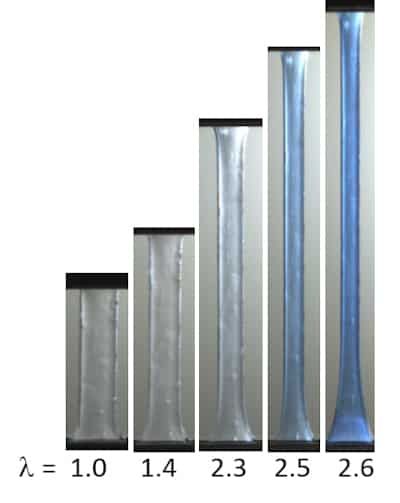
Directly measuring stresses in soft materials as they deform is no easy task, but a team of researchers in France and the US have now developed a colour-changing force-responsive probe that can do just that. The device, which is based on a force-sensitive molecule embedded in an elastic polymer (elastomer) network, can be used to build up a quantitative map of internal forces in a structure by optical means alone.
When a mechanical load is applied to an irregularly-shaped object, the stresses and strains it produces will also be irregular. Measuring these internal forces is important for predicting where the object will break, but because soft materials often deform considerably before they fail, such measurements are particularly difficult to make.
At present, only a few techniques can directly measure stresses in soft materials. The most common method is to measure strains and then perform a mathematical simulation to calculate the corresponding stresses. Such calculations are, however, known to be unreliable for large strains and strong strain gradients.
Force-sensitive molecules
In recent years, researchers have been exploring ways of making stress sensors out of force-sensitive molecules incorporated into polymers. When these “mechanophore” molecules are activated by a force of a sufficient size, they undergo chemical reactions that cause their optical properties (such as fluorescence, luminescence and colour) to change.
One commonly-used mechanophore is an organic compound known as a spiropyran. When a spiropyran-containing polymer network deforms, the forces on the bonds of this molecule cause it to transform into a chemical variant called merocyanine that absorbs visible light. By shining a light on the sample and monitoring its change in colour from transparent to blue, researchers can therefore directly measure the fraction of molecules that have undergone the chemical reaction. This, in turn, gives them a measure of the average stress applied on the material at the point at which the colour change is observed.
Mechanochemistry
“This field of study is called mechanochemistry – that is, chemistry triggered by mechanics,” explains Costantino Creton from the ESPCI in Paris, who led the new research effort. “It opens many possibilities for measuring internal forces using optical visualization techniques alone.”
Going from qualitative colour-change detection to quantitative mapping of heterogenous stress fields is not as easy as it sounds, however. For one, Creton and colleagues note that the spiropyran must be randomly and homogenously incorporated into the material being tested. The average force produced on the molecule must also be directly related to macroscopic stress applied, and the molecular sensor should activate before the material breaks.
A calibration curve
The researchers tested their technique on two elastomer materials with very different hardening properties. They began by incorporating spiropyran into these materials as a cross-linker and tracked the colour change of the molecule as they applied tension to the samples along a single axis. By varying the concentration of the spiropyran within the network of the elastomers, they produced a calibration curve of applied stress versus colour change. They then used this stress-colour curve to determine the stress distribution around pre-existing cracks within the samples. This stress distribution would be much more difficult to obtain using conventional techniques, as mentioned, since the materials host strong localized stress gradients.

Ink-free polymers colour under stress
Afterwards, the team, which also includes researchers from the University of Colorado at Boulder, compared the experimental stress fields with theoretical simulations of the same materials. The optical measurement exactly matched these calculations, thus validating the method, Creton says.
This internal probe technique, which is detailed in Science Advances, could be used to test statistical fracture modelling of soft, tough materials and more generally to quantify stresses in irregularly-shaped objects from simple optical observations with a (red-green-blue) camera, he adds.
The researchers say they would now like to try out their approach on composite materials with a wider range of applications. “We would also like to test metamaterials, which have very heterogenous internal structures and complex mechanical behaviours,” Creton tells Physics World. These materials are artificially-engineered compounds with properties such as a negative Poisson ratio that are rare or absent in natural materials.
"soft" - Google News
June 30, 2020 at 03:57PM
https://ift.tt/2AePNfd
Colour-changing probe maps stresses in soft materials – Physics World - physicsworld.com
"soft" - Google News
https://ift.tt/2QZtiPM
https://ift.tt/2KTtFc8
Bagikan Berita Ini














0 Response to "Colour-changing probe maps stresses in soft materials – Physics World - physicsworld.com"
Post a Comment